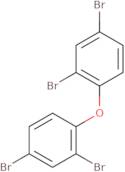BDE No 47 solution
CAS: 5436-43-1
Ref. 3D-FAA43643
| 5mg | Descontinuado | ||
| 10mg | Descontinuado | ||
| 25mg | Descontinuado | ||
| 50mg | Descontinuado | ||
| 100mg | Descontinuado |
Informação sobre produto
- 1,4-Dibromo-2-(2,4-Dibromophenoxy)Benzene
- 2,2',4,4'-Tetrabromodiphenyl oxide
- 2,2'4,4'-Tetrabromodiphenyl ether
- 2,2′,4,4′-Tetrabromodiphenyl ether
- 2,2′,4,4′-Tetrabromodiphenyl oxide
- 2,4,2',4'-Tetrabromodiphenyl ether
- 2,4,2′,4′-Tetrabromodiphenyl ether
- 2,4-Dibromo-1-(2,4-dibromophenoxy)benzene
- 5436-43-1
- Bde 47
- Ver mais sinónimos
- Benzene, 1,1'-oxybis[2,4-dibromo-
- Benzene, 2,4-dibromo-1-(2,4-dibromophenoxy)-
- Bis(2,4-dibromophenyl) ether
- Nsc 21724
- Pbde 47
- 1,1'-Oxybis(2,4-dibromobenzene)
BDE-47 is an ether that has been shown to inhibit axonal growth and cause neuronal death in rats. This substance may also have toxic effects on the brain, interfering with its functions and causing physiological effects. BDE-47 has been found to inhibit mitochondrial membrane potential, enzyme activities, and cellular energy metabolism. The toxicity of this chemical has been studied extensively in humans and animal models, as well as in vitro systems. BDE-47 has been shown to be toxic to both male and female rats by altering thyroid hormone levels. The neurotoxic effects of BDE-47 are due to inhibition of the enzyme activity of cytochrome P450 (CYP) enzymes. A recombinant CYP system was used to study the effect of BDE-47 on a rat liver cell line (H4IIE cells) that overproduces CYP enzymes. In these studies, BDE-47 inhibited CYP2B6 activity by 50%, leading to decreased levels of 2,





